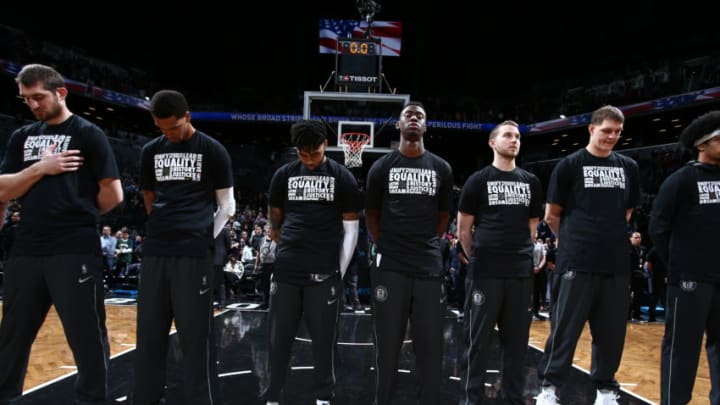Without any path to success this year, the Brooklyn Nets have consistently had a long-term outlook behind all their moves. With the long game comes short-term progress reports that, in the aggregate, should help a franchise analyze properly.
When the 2016 NBA Draft rolled around, the Brooklyn Nets were a laughingstock around the league. Owing their first round pick to the Boston Celtics outright, following a season that resulted in more jokes about “the worst trade in history” than wins, was far from optimal.
The franchise outlook, at that point, was bleak. This was newly-hired general manager Sean Marks‘ first chance to either give fans some hope, or give them more reasons to jump ship.
Considering his resources, Marks made something out of nothing. He traded Marcus Paige, the 55th overall pick, and $3 million in cash to the Utah Jazz for Isaiah Whitehead, the 42nd pick. This obviously was not a blockbuster move, but the Nets had to start small.
Devoid of a first-rounder, Marks got one two weeks later by flipping Thaddeus Young for the 20th overall pick, Caris LeVert from Michigan, and a future second round pick (protected 45-60). This was a great trade for the sake of what the Nets needed to do: accumulate young assets. Finding a guy with upside as high as LeVert’s that late in the first round of the draft was impressive as well.
Since they have been under the watch of the Nets for almost two seasons now, it feels necessary to dissect their progress so far.
Isaiah Whitehead
Nicknamed “The Cyclone,” Whitehead gave Nets fans a mixed bag in his rookie campaign. He did not make immediate leaps of success, but Whitehead did show promising signs of captaining Kenny Atkinson’s high-octane offense.
With the ball in his hands, Whitehead made interesting decisions. They were not always smart ones, but he was given some artistic license in the backcourt. Honestly, that’s how point guards need to be developed: with full rein over the offense.
More from Brooklyn Nets
- Why the new-look Brooklyn Nets are guaranteed to surprise
- NBA Trades: This Mavs-Nets deal may lead to Dallas adding a third star
- 5 NBA players everyone should be keeping a close eye on in 2023-24
- 5 NBA players facing do-or-die 2023–2024 seasons
- Is Mikal Bridges the Brooklyn Nets next star?
Getting advice from veteran Jeremy Lin probably helped Whitehead tremendously. If anyone knows how to go from rags to respectability, it’s Lin.
The glimpses of promise were few and far between, but Whitehead showed a possible future as a rotational combo guard. The fact that Spencer Dinwiddie ended up being far more efficient is not exactly his fault, but Whitehead went into the 2017 offseason with a lot of work to do.
In that summer, the Nets added another guard: D’Angelo Russell. The uphill battle grew even steeper for Whitehead.
Lin got injured (again) early in the 2017-18 season, as did Russell, which opened up minutes for Whitehead. With them, he had, once more, a mixed bag. He’s hitting 41.2 percent of his 3-point attempts, a significant improvement from last year’s 29.5 percent clip. However, his assist-to-turnover ratio is below 1.0.
If that does not improve drastically, Whitehead will have a tough time earning more minutes. He is undersized for a 2-guard at 6’4″, which means he will have to become a capable playmaker.
Caris LeVert
Like Whitehead, LeVert was traded for by Marks. They wanted him. Unlike Whitehead, LeVert had far more upside as a prospect. His lanky frame, deft ball-handling, and off-the-dribble scoring skills made for a solid foundation of a player.
In a system where the ball is shared and players have versatile roles, that is crucial and valuable. He could potentially initiate a pick-and-roll, dive on one, pop off of one, and even cut on the baseline for an easy deuce or open trey.
His rookie campaign involved a boatload of these things. Trial by fire, if you will. That type of initiation is crucial for being part of a system like Atkinson’s, considering the myriad of different roles he puts players in.
No superior bolster of this claim exists than the fact that Allen Crabbe, considered a shooting specialist before being poached by Brooklyn, now regularly initiates PNRs. And LeVert got a taste of this in his rookie season, initiating an average of 1.7 pick-and-roll possessions per game as the ball-handler.
Additionally, 30.8 percent of his possessions last season result in spot-up opportunities. To say the least, LeVert was the antithesis of a specialist. In neither category was he elite in terms of efficiency, but who is as a rookie? Just the idea that he was capable to fit into any piece of the puzzle was sufficient enough promise for the franchise.
So far this season, LeVert has shown respectable improvement. He is still not exceptional in either pick-and-roll ball-handling or spot-up efficiency, lurking below the 50th percentile in both, but let’s not act like he has legitimate production to make plays with.
The macro
The team’s own 2018 first round pick (which they do not own anymore) is valuable for a reason. LeVert is not completely liable for this lack of production. For that matter, neither is Whitehead. Context is crucial when analyzing prospects in these types of situations. Efficiency matters, but only as much as the supporting cast.
The Nets are far from contention. That burden does not entirely fall on either of these guys.
Next: 2017-18 Week 18 NBA Power Rankings
The future is bright in Brooklyn. Don’t let the numbers skew that hope.
